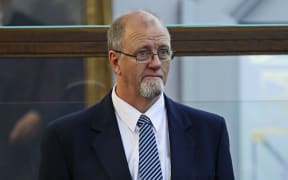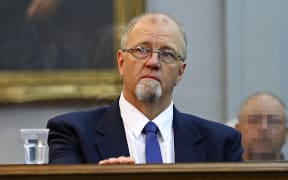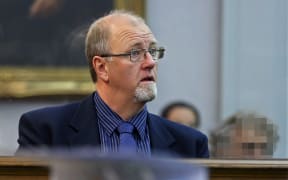Christine Lundy was killed by someone who wanted to wipe her off the face of the earth, and her daughter was collateral damage, the High Court in Wellington has been told.
Mr Lundy, 56, is accused of murdering his 38-year-old wife and seven-year-old daughter, whose bodies were found in their Palmerston North home on 30 August 2000; the Crown claims Mr Lundy killed his wife for her insurance money and Amber because she saw what he was doing to her mother.
The prosecution and defence have wound up more than six weeks of evidence and Crown prosecutor Philip Morgan, QC, this morning finished presenting his closing argument.
Key points from day 33:
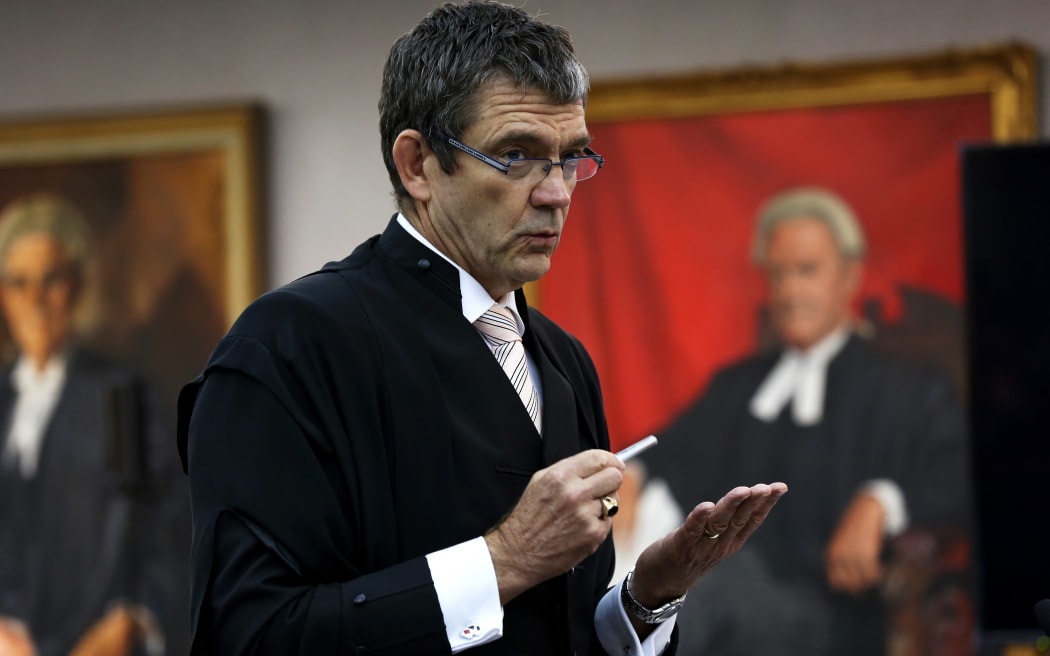
Crown prosecutor Philip Morgan, QC Photo: RNZ / Alexander Robertson
The most compelling evidence was "Mark Lundy had Christine Lundy's brain on his shirt", Mr Morgan said.
A number of experts, both prosecution and defence, had all agreed matter found on Mr Lundy's polo shirt was central nervous system (CNS) tissue from the brain or spine.
"The Crown's case, members of the jury, is that he's the killer, and he's the killer because he had his wife's brain on his shirt.
"No husband should have his wife's brain on their shirt."
However, that was not the only thing which pointed to him as the killer, he said; his car had unaccounted for kilometres on it, its petrol consumption did not add up and a fellow inmate of Mr Lundy's - known as Witness X - said the accused told him he was only there because his daughter had seen what he was doing to his wife.
"The car tells us how far he travelled the shirt tells us where he went and who he did this to," Mr Morgan said.
"Witness X tells us why Amber had to go, too.
"This was committed by somebody who wanted to wipe Christine Lundy off the face of the earth.
"Amber was collateral damage."
Mr Lundy was the killer, and the jury should find him guilty, Mr Morgan concluded.
Defence opens closing argument
Lead defence lawyer David Hislop, QC, started presenting his closing argument this afternoon.
Mr Hislop opened by promising the jury he would refrain from using sarcasm and hyperbole, and from criticising forensic experts.
"This is not a forensic jousting match. This is about this man's life and the matters that you have to consider are serious enough without forensic techniques standing in your way."
The jury must approach its task calmly and dispassionately, he said.
Mr Hislop said the fact there was brain on Mr Lundy's shirt was not what the case should be decided on.
"Of course there were two horrible, horrible deaths, and of course there was brain everywhere."
However, it could have got there through contamination; the first time the substance was identified as CNS tissue was after it had been turned into paraffin blocks for testing in the United States.
It had also not been proven that the CNS was human.

Mark Lundy's lead lawyer David Hislop, QC Photo: RNZ / Alexander Robertson
Mr Hislop said tests the police carried out showed Mr Lundy simply did not have enough petrol in case car for a round trip from Petone to Palmerston North to kill his family, as the Crown claims.
"There was no secret journey because he simply did not have enough petrol," he said.
As well, the police analyst who looked at where Mr Lundy had travelled and came up with hundreds of missing kilometres had not allowed for any personal travel for a "a travelling salesman with a young child and busy social life".
"It bears no relationship to reality at all."
The jury did not have to be mathematicians to work out that Mr Lundy would have had to travel only an extra 37km on each of those days to account for the missing kilometres.
"That's called reality. what she was doing was guessing. She was crunching the numbers as far as she could to get a result.
"It is speculation ... and criminal trials are simply no place for that type of logic."
Time of death debated
Mr Hislop said it was known Mrs Lundy habitually turned off her computer before going to bed, and that it had been turned off about 11pm that night.
A neighbour reported seeing lights on and the conservatory door open about 11pm, and hearing a smashing sound just before midnight.
"If it's right, it's possible, just possible, that the intruder was already in there," Mr Hislop said.
"If that's the case it was impossible that it was Mark Lundy."
Mr Hislop said he agreed with the prosecution that stomach contents were a notoriously unreliable way to determining time of death.
"But what isn't unreliable is the length of time from eating to having an empty stomach."
Both victims had full stomachs, and it was known they had bought McDonalds about 6pm. However, crinkle-cut potato chips and fish and chip-style fries were seen in their stomach contents.
"Is he [Mr Morgan] seriously suggesting that later that night there was another secret journey, by Christine Lundy, to get fish and chips?
"It is nonsense. Complete arrogant nonsense."
That would mean leaving Amber in bed, going to get the fish and chips and then "dragging her out of bed and forcefeeding her the different chips".
"It doesn't work at all. It's nonsense. But that's what happens when you try to force evidence into a particular piece of hypothesis."
Court told of 'killing trip'
Earlier today, Mr Morgan told the seven-man, five-woman jury Mr Lundy's car had both mileage and petrol discrepancies, which proved he had taken a secret round trip from the Petone motel he was staying in, while on business selling sinks in the capital, and his home in Palmerston North - a "killing trip".
"There's no way in the world that when he made the killing trip, the one sometime after 1am in the morning up to Palmerston North, where the killings occurred, that he was driving like a mad thing," Mr Morgan said.
"The last thing he wanted was to draw attention to himself."
The only leg of his trip where he was speeding was when he rushed back to Palmerston North on 30 August after a friend told him to get home as there were police at his house, and there had been an unexplained killing in the city.
"There was only one leg where he drove fast. The killing trip, of course, he would have done as unobtrusively as possible."
Mr Morgan said Mr Lundy's car told the story of the "killing trip"; it had 80,589km on the clock when it was serviced on 21 August. Nine days later, when Mr Lundy was stopped as he drove into Palmerston North, it had 81,859km on it. The difference was 1270km but using Mr Lundy's accounts of his travel and cellphone records, the distance he travelled was actually only 847km, plus a bit for local travel.
The 423km left was more than enough for the about 300km round trip from Petone to Palmerston North to carry out the killings, he said.
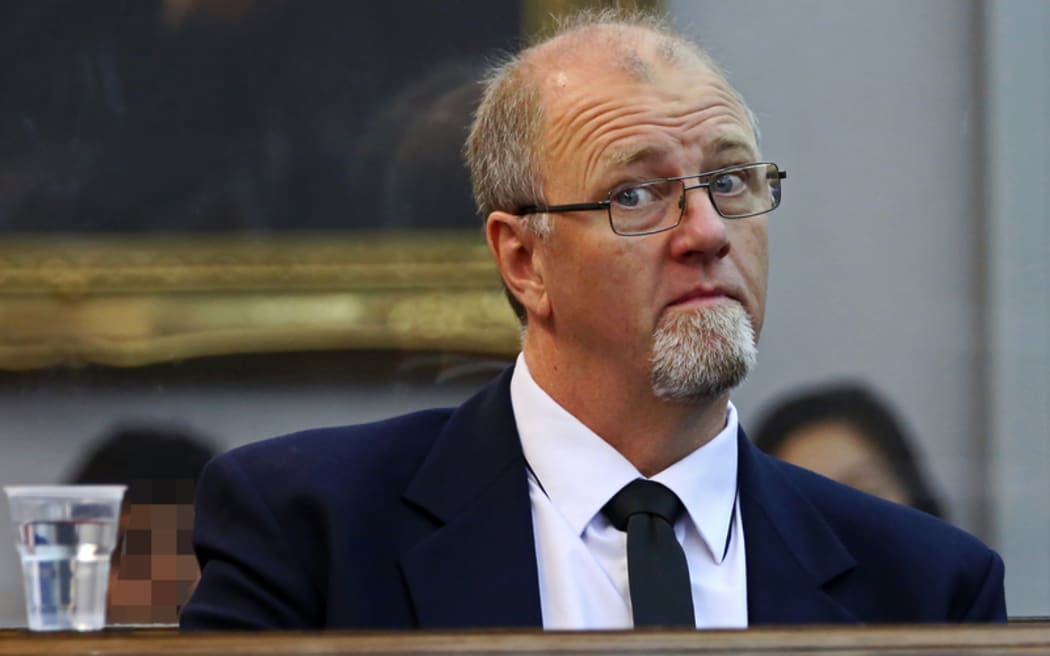
Mark Lundy took a secret "killing trip" to Palmerston North, the prosecution said. Photo: RNZ / Alexander Robertson
Mr Lundy's fuel tank also told a story, Mr Morgan said.
He had filled up in Lower Hutt on the afternoon of 29 August, and his car's tank had a capacity of 68 litres.
Mr Morgan said when Mr Lundy was stopped driving into Palmerston North the fuel tank had only 10.1 litres left, meaning he had used 27.8 litres per 100km; Ford factory figures put the consumption of Ford Fairmonts at 13 litres per kilometre on the open road and 8 litres on the highway.
The court heard he had travelled 461km on the previous tank but, if his account was correct, he achieved only about 200km on the next trip. The car's petrol light was on when he was pulled over in Palmerston North.
'Who kills a little girl?'
The defence had tried to portray the killings as a random burglary gone wrong, but Mr Morgan questioned why anyone would choose the Lundy's house to burgle given it was in a blue-collar suburb with no obvious signs of wealth.
"Who attacks a woman lying flat on her back on bed? Who kills a little girl?
"The fact that Christine Lundy was attacked while she was flat on her back in her bed and probably asleep, and the fact that Amber Lundy was attacked at all, demonstrates that these aren't killings by a random burglar who has been detected in his crime and lashes out in a random panic."
The killer focused on Mrs Lundy's face "in an effort to obliterate it" and then, seeing he was being observed by a little girl, "turns and chops her in exactly the same way".
The burglar then managed to take a large, heavy jewellery box - leaving more obvious items such as Mrs Lundy's handbag and a camera - and got out of the house without leaving a trace of blood or brain anywhere.
"That's the actions of some random burglar?" Mr Morgan said.
"Does that really sound to you like what something someone who is a stranger to this house would do?"
Mr Morgan said the evidence showed the killings were not random and were not carried out by anyone other than Mr Lundy.
Mr Lundy was driven by growing financial desperation, Mr Morgan said. He had unconditionally signed up to buy $1 million of land for a vineyard venture and was given until 30 August to pay for the land or face a $100,000 penalty interest bill.
"30 August. Now there's a bit of a coincidence," Mr Morgan said.
"Can you imagine how happy his wife would have been about that?"
Mrs Lundy was usually a very private and positive person but in 2000 she started expressing concern about their financial situation.
"This was a family in financial crisis. It was catastrophe time," Mr Morgan said.
*Clarification - For the avoidance of doubt, please note that Radio New Zealand reporter Sharon Lundy is no relation to Mark Lundy.

